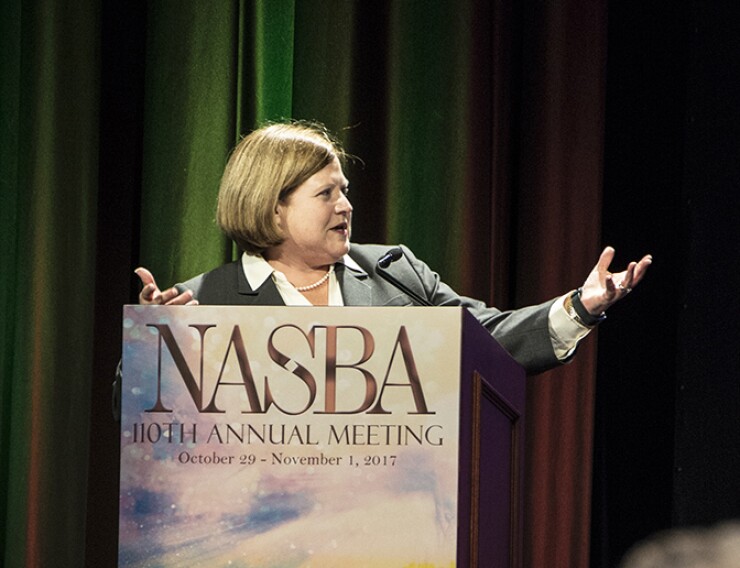The new version of the CPA Exam that launched in April has performed well, according to two of its architects – but that doesn’t mean they’re finished changing it.
Reporting on the results of the new exam at the 110th Annual Meeting of the National Association of State Boards of Accountancy, American Institute of CPAs’ vice president of examinations Michael Decker told attendees, “It was very well-received. Candidates said that it mimicked what they were doing in their day-to-day jobs.”
“Top of mind for us is making the exam as relevant as it can be,” explained his co-presenter, NASBA executive vice president and chief operating officer Colleen Conrad, so having more and more of the test reflect the real-world environment that CPAs operate in is a priority.
Decker pointed out that other tweaks in the new exam have paid off in higher completion rates. He cited the fact that, previously, between 7 and 12 percent of candidates wouldn’t finish the Financial Accounting and Regulation, or FAR, section of the exam, so they lowered the number of simulations in the section from nine to eight, and saw non-complete rates drop.

“Any time you launch a new exam,” he added, “you worry about the rush of candidates coming to take the old version. But candidate numbers have rebounded from those who rushed in to get the last of the old exam. Pass rates dropped off heading into the new exam as people rushed to take the old exam – and maybe many of them were not ready – but rates have rebounded to normal levels.”
Both the AICPA and NASBA will continue to monitor pass rates every quarter.
Future exam
Looking ahead, there are plenty of changes in store both within the exam itself and in how and where it’s administered.
A new release is planned for April 1, 2018, that will be optimized for the 23-inch monitors in use at the official testing sites, and will included a refreshed user experience, according to Decker. The exam architects are also adding a central element of the modern accountant’s toolkit to the exam: Excel.
“We’re out meeting with firms and trying to figure out how the exam needs to change to stay relevant to the needs of the profession,” Decker said.
In part, that will mean more rapid change. “We’re moving from an exam that changes every five to seven years to one that keeps up with all the changes that are coming our way,” Conrad explained. “I have faith that it’s going to continue to evolve to keep pace.”

She noted that NASBA is working with all 55 state boards on harmonizing and simplifying the rules and regulations across the country – coming up with a single definition for “test window,” for instance. They are also exploring ways to reduce the blackout periods when the exam isn’t available, aiming to get candidates their scores faster, and giving them more opportunities to take the exam. Another idea under consideration is allowing for block scheduling for the exam, in which Conrad said some firms had expressed interest.
Beyond the U.S., NASBA is looking to expand the number of countries that can send candidates to central locations to sit the exam – for instance, allowing citizens of Caribbean nations where the exam isn’t offered to test in Brazil, where it is. In addition, the association is looking at India and China as potential exam sites.
Building the pipeline
While NASBA and the AICPA don’t want to diminish the difficulty of the exam or cheapen the value of the credential that results, they are interesting in increasing the number of candidates.
“In the old days, NASBA stayed away from pipeline issues, on the theory that we are the regulators, and we shouldn’t be promoting the profession,” Conrad explained. “But the drop in the pipeline created a public protection issue, so now we’re looking at building that pipeline.”
“What can we do to keep talented people in the pipeline?” Decker asked – a question that prompted NASBA and the AICPA to conduct research among “incompletes,” or candidates who haven’t completed the entire exam (“We don’t call them dropouts,” he said).

Fully 85 percent of incompletes are from business, industry and government, as opposed to candidates from public accounting, and they are generally much less likely to get support from their employers. “It’s a longshot if you’re not in public accounting,” he said, “and you need a strong and ongoing motivation to get your CPA.”
Encouraging employers to pay for or help with the expense of both sitting and preparing for the exam, and to give candidates time to study, are the three most important things the profession can do to boost the pipeline of exam-takers. After that, Decker said that promoting the value of the CPA credential on college campuses would be useful, as would offering more classes tailored to the exam.
The good news is that even among those who didn’t pass the exam, 50 percent still hope to get it, Decker reported – and they’re not aiming at another credential.





